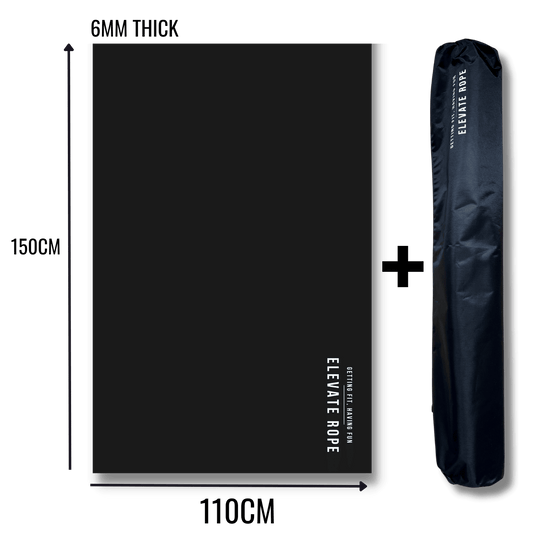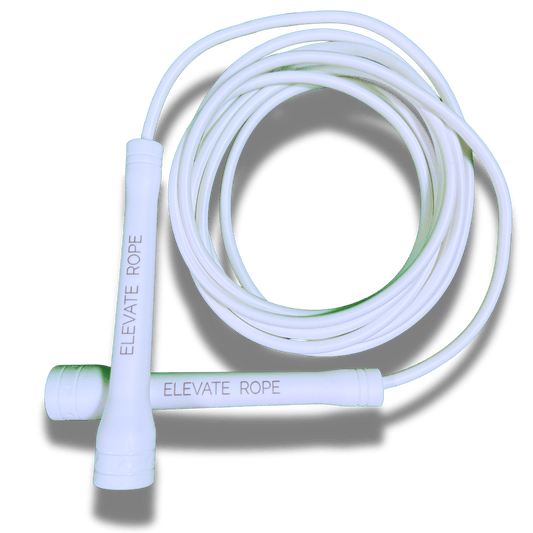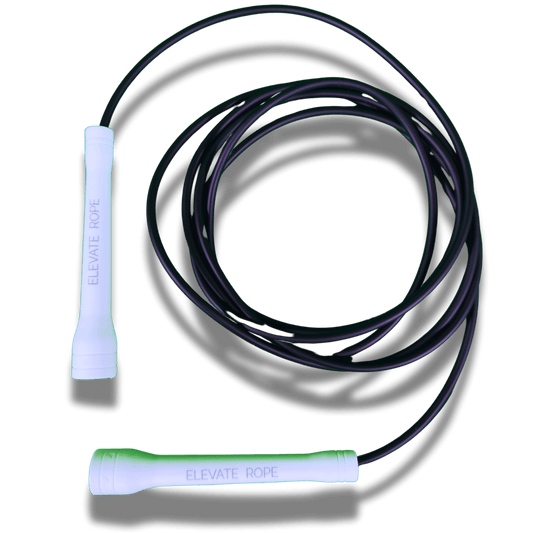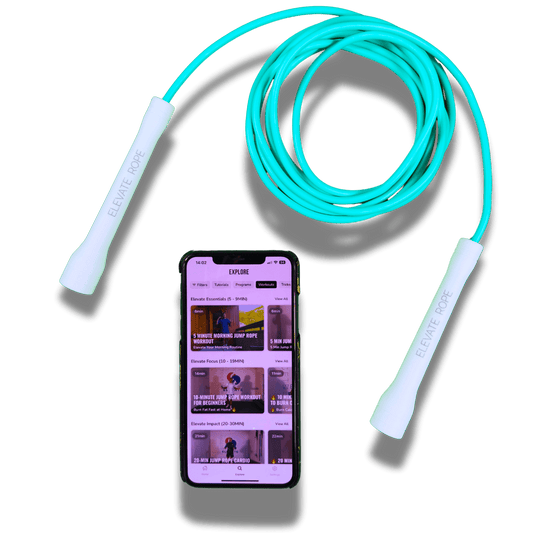Por qué el registro con la cuerda para saltar es importante para la disciplina
Cuando se trata de desarrollar disciplina con la cuerda para saltar, el primer paso es registrar el progreso. Registrar tu avance es más que anotar números. Se trata de convertir tu entrenamiento en un sistema de responsabilidad y motivación.
Como entusiastas de la cuerda para saltar, a menudo pensamos en el éxito como algo inmediato: un nuevo récord personal o perfeccionar un movimiento difícil. Sin embargo, el progreso real se mide con el tiempo. Aquí es donde entra el registro. Al anotar tus entrenamientos, ves lo lejos que has llegado, incluso cuando la mejora no es evidente.
Registrar te ayuda a entender las pequeñas victorias. Puede que hayas mejorado tu resistencia, saltado más veces o dominado un nuevo truco. Estas victorias incrementales se acumulan. Refuerzan tu compromiso con la rutina.
Pero hay más en el registro que solo números. Te ayuda a evaluar qué funciona y qué no en tu rutina. Esto facilita ajustar y optimizar tu entrenamiento. Registrar te ayuda a afinar tu estrategia y mantenerte alineado con tus objetivos.
Este método convierte la disciplina de algo que "intentas" hacer en algo arraigado en tu rutina. Una vez que el registro con la cuerda para saltar forma parte de tu proceso, te mantiene constante y motivado.

La importancia de registrar el progreso con la cuerda para saltar: establecer pequeños hitos y medir el éxito
Establecer pequeños hitos alcanzables es esencial para desarrollar disciplina con la cuerda para saltar. Dividir un objetivo mayor en pasos más pequeños y manejables hace que el progreso se sienta menos abrumador y te mantiene motivado en el camino. Por ejemplo, comienza apuntando a 100 saltos seguidos, luego aumenta tu meta a 200 y sigue estableciendo nuevos objetivos a medida que mejoras.
Registrar estos hitos no solo te da una sensación de logro, sino que también proporciona una retroalimentación clara sobre cuánto has mejorado. Al enfocarte en estas pequeñas victorias, evitas sentirte desanimado por el objetivo mayor y en cambio construyes confianza a través del progreso constante. Con el tiempo, estos micro-objetivos se suman a una mejora significativa, reforzando tu compromiso con la rutina.
A medida que continúas alcanzando estos hitos, desarrollarás una mentalidad de crecimiento, viendo los desafíos como oportunidades para mejorar en lugar de obstáculos. Es importante revisar y ajustar regularmente tus objetivos a medida que avanzas, manteniéndolos realistas y alineados con tus habilidades.
Para más información sobre cómo las pequeñas victorias contribuyen a fortalecer la mente, consulta nuestra publicación en El ciclo de la confianza: cómo las pequeñas victorias construyen la fortaleza mental.
La importancia de registrar el progreso con la cuerda para saltar: establecer pequeños hitos y medir el éxito
Establecer pequeños hitos alcanzables es esencial para desarrollar disciplina con la cuerda para saltar. Dividir un objetivo mayor en pasos más pequeños y manejables hace que el progreso se sienta menos abrumador y te mantiene motivado en el camino. Por ejemplo, comienza apuntando a 100 saltos seguidos, luego aumenta tu meta a 200 y sigue estableciendo nuevos objetivos a medida que mejoras.
Registrar estos hitos no solo te da una sensación de logro, sino que también proporciona una retroalimentación clara sobre cuánto has mejorado. Al enfocarte en estas pequeñas victorias, evitas sentirte desanimado por el objetivo mayor y en cambio construyes confianza a través del progreso constante. Con el tiempo, estos micro-objetivos se suman a una mejora significativa, reforzando tu compromiso con la rutina.
A medida que continúas alcanzando estos hitos, desarrollarás una mentalidad de crecimiento, viendo los desafíos como oportunidades para mejorar en lugar de obstáculos. Es importante revisar y ajustar regularmente tus objetivos a medida que avanzas, manteniéndolos realistas y alineados con tus habilidades.
Para más información sobre cómo las pequeñas victorias contribuyen a construir fortaleza mental, consulta nuestra publicación sobre El Ciclo de la Confianza: Cómo las Pequeñas Victorias Construyen Fortaleza Mental.
Herramientas de Seguimiento: Usando Aplicaciones, Diarios y Hojas de Cálculo
Para seguir efectivamente tu progreso con la cuerda para saltar, usar las herramientas adecuadas es clave. Ya prefieras diarios, aplicaciones o hojas de cálculo, registrar tus entrenamientos te ayuda a mantenerte organizado, enfocado y motivado.
Para principiantes, un diario de entrenamiento simple puede ser increíblemente útil. Anota tus saltos, la duración del entrenamiento y cualquier técnica en la que estés trabajando. Esto te permite mirar hacia atrás y ver el progreso, incluso en días donde la mejora no es evidente.

Para quienes prefieren la tecnología, aplicaciones como Strava o MyFitnessPal facilitan el seguimiento. Registran el tiempo dedicado a saltar, las calorías quemadas y a veces incluso establecen desafíos para mantener el interés. Muchas aplicaciones también proporcionan gráficos visuales que te ayudan a ver la mejora con el tiempo, lo cual puede ser muy motivador.
Si prefieres un enfoque más personalizado, las hojas de cálculo ofrecen una forma flexible de registrar detalles específicos. Puedes crear columnas para el número de saltos, trucos practicados y cómo te sentiste durante la sesión. Este método ayuda a seguir tanto el progreso físico como mental, dándote una visión más holística de tu viaje con la cuerda para saltar.
Sea cual sea la herramienta que elijas, lo importante es la consistencia. Registrar tus sesiones regularmente te ayudará a mantenerte responsable y asegurar que sigas en camino con tus objetivos. Con el tiempo, notarás cómo el seguimiento contribuye a construir disciplina con la cuerda para saltar.
Construyendo Consistencia: Cómo el Seguimiento Refuerza la Disciplina
La consistencia es clave para dominar la cuerda para saltar. Al registrar regularmente tu progreso, refuerzas tu compromiso y disciplina. Cada vez que registras una sesión, ves lo lejos que has llegado, lo que te motiva a continuar.
El seguimiento te ayuda a reconocer patrones en tu rutina, como los momentos en que estás más enérgico o los calentamientos específicos que mejoran tu rendimiento. Esta información te permite optimizar tu entrenamiento y hacer que tus ejercicios sean más efectivos.
Además, ver tu progreso a lo largo del tiempo aumenta la confianza. Cuando te sientes estancado, mirar hacia atrás en tu progreso registrado muestra cuánto has logrado. Pequeñas victorias — ya sea aumentar tus saltos o dominar un nuevo truco — se suman y te mantienen motivado.
Para mejorar tu entrenamiento y mantener la constancia, mira este video de Geraldo Alken, que ofrece consejos y técnicas útiles:
Usar este recurso junto con el seguimiento de tu progreso puede ofrecer orientación adicional, haciendo que tu viaje con la cuerda para saltar sea aún más gratificante.
Analizando el Progreso: Reflexionando sobre lo que Funciona y lo que No
Seguir tu progreso con la cuerda para saltar no es solo registrar números. También se trata de analizar esos datos para entender qué funciona y qué necesita ajuste. Después de seguirlo por unas semanas, surgirán patrones: tal vez consistentemente alcanzas tus objetivos de saltos, o quizás ciertos trucos aún te desafían. Esta información es invaluable para perfeccionar tu enfoque.
La reflexión es una parte crucial del proceso. Al revisar tus datos, puedes identificar áreas donde estás mejorando y áreas donde quizás necesites enfocar más esfuerzo. Por ejemplo, si notas que tu resistencia ha aumentado pero tu técnica para ciertos trucos no ha mejorado, puedes ajustar tu entrenamiento para priorizar esas habilidades específicas.
Analizar tu progreso también te ayuda a establecer metas realistas. A medida que continúas con el seguimiento, obtendrás una comprensión más profunda de tus capacidades actuales y sabrás cuándo es momento de esforzarte más. Esta perspectiva evita que establezcas objetivos demasiado ambiciosos demasiado pronto, lo que puede llevar al agotamiento o la frustración.
Recuerda, el seguimiento es un proceso dinámico. No se trata solo de medir tu éxito; se trata de tomar decisiones informadas que guíen tus próximos pasos. Reflexionar consistentemente sobre tu progreso y ajustar tu enfoque te mantiene en el camino hacia una mejora a largo plazo.
Al hacer del análisis parte de tu rutina, aseguras que tu viaje con la cuerda para saltar se mantenga tanto motivador como efectivo.
Celebrando Victorias: Premiándote por Alcanzar Hitos
Celebrar los hitos es crucial para mantener la disciplina en el seguimiento del salto de cuerda. No se trata solo de marcar un objetivo, sino de reconocer el esfuerzo que tomó lograrlo. Reconocer tu progreso te da una sensación de logro y te mantiene motivado para el siguiente paso.
La celebración no necesita ser extravagante. Puede ser algo simple, como tomarte un momento para reflexionar sobre tu camino o premiarte con equipo nuevo o un merecido día de descanso. Estas pequeñas recompensas refuerzan el hábito y te ayudan a mantener la constancia.
La clave es hacer de la celebración una parte regular de tu rutina. Cada vez que alcances un hito, aprovecha la oportunidad para apreciar lo lejos que has llegado. Esto aumenta tu confianza y fortalece tu compromiso para seguir trabajando hacia tu próximo objetivo.

Para saber más sobre cómo celebrar pequeñas victorias puede mejorar tu bienestar mental, consulta este artículo de Psychology Today: Por qué es importante celebrar las pequeñas victorias.













